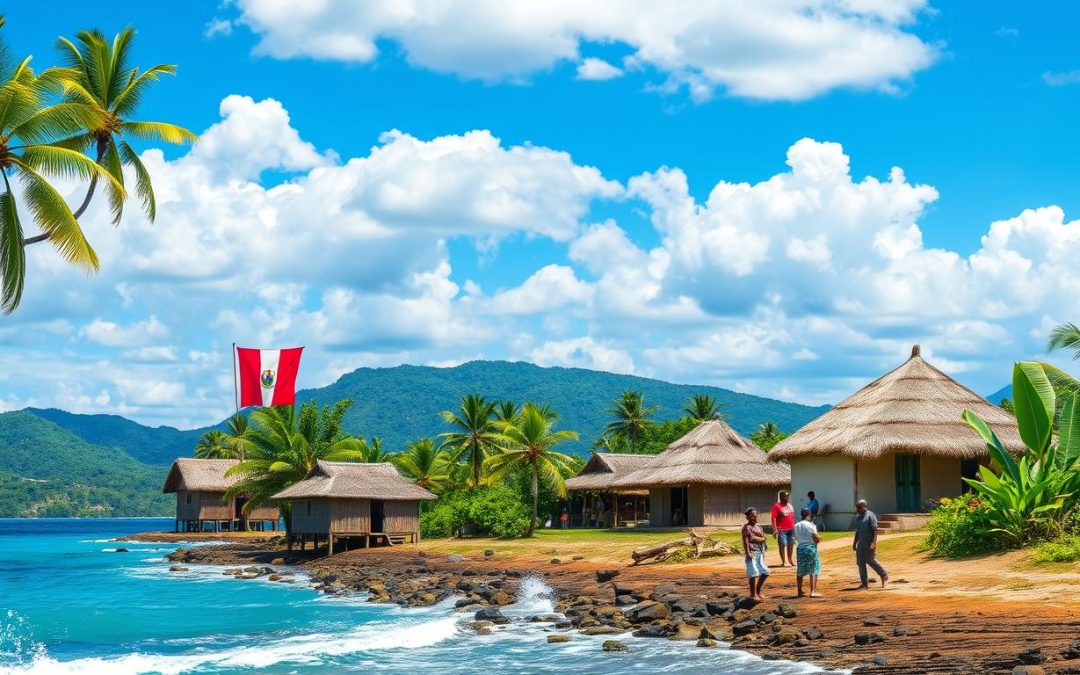Ever wondered how a small African nation became the only Spanish-speaking country on the continent? Equatorial Guinea is a fascinating puzzle that challenges our views on language and culture.
Located on the west coast of Central Africa, Equatorial Guinea has a unique language heritage. It has three official languages: Spanish, French, and Portuguese. This small nation shows an amazing linguistic diversity, reflecting its complex history and culture.
Exploring Equatorial Guinea’s language landscape reveals a story of adaptation and resilience. Spanish is the main language, spoken by about 87% of the people. It makes Spanish the most used official language in this lively country.
Key Takeaways
- Equatorial Guinea is the only Spanish-speaking country in Africa
- Spanish is spoken by 87% of the population
- The country has three official languages: Spanish, French, and Portuguese
- 15 additional languages exist without official status
- Linguistic diversity reflects the country’s rich cultural heritage
Overview of Equatorial Guinea’s Linguistic Heritage
Explore the rich language history of Equatorial Guinea. Here, indigenous languages and colonial influences create a complex cultural story. The country’s language scene shows the impact of migration, colonization, and cultural change over time.
The language story of Equatorial Guinea starts with the Bantu migrations. These migrations happened around 2,000 BC. People moved from southeastern Nigeria to northwestern Cameroon.
By 500 BC, Bantu-speaking groups had settled in what is now Equatorial Guinea. They came from the regions between southeastern Nigeria and northwestern Cameroon.
Roots of Linguistic Diversity
To understand the language heritage, we must look at the ethnic mix:
- Fang ethnic group: 85.7% of the population
- Bubi: 6.5% of inhabitants
- Ndowe: 3.6% of the population
- Other indigenous groups: Approximately 4.2%
“Language is the roadmap of a culture. It tells you where its people come from and where they are going.” – Rita Mae Brown
The indigenous languages of Equatorial Guinea belong to the Bantu family. These languages are more than just a way to talk. They hold cultural memory, traditional knowledge, and social identity.
| Language Family | Primary Speakers | Geographical Concentration |
|---|---|---|
| Bantu Languages | Fang, Bubi | Mainland and Bioko Island |
| Spanish | 87.7% population proficiency | Nationwide |
The arrival of European colonizers, especially the Spanish, changed the language scene. Spanish became the official language. This created a unique setting where indigenous and colonial languages coexist.
Spanish as the Primary Official Language
Equatorial Guinea is a special case in Africa. It’s the only country where Spanish is the official language. Spanish is deeply woven into the country’s culture and government, helping 1.6 million people communicate.
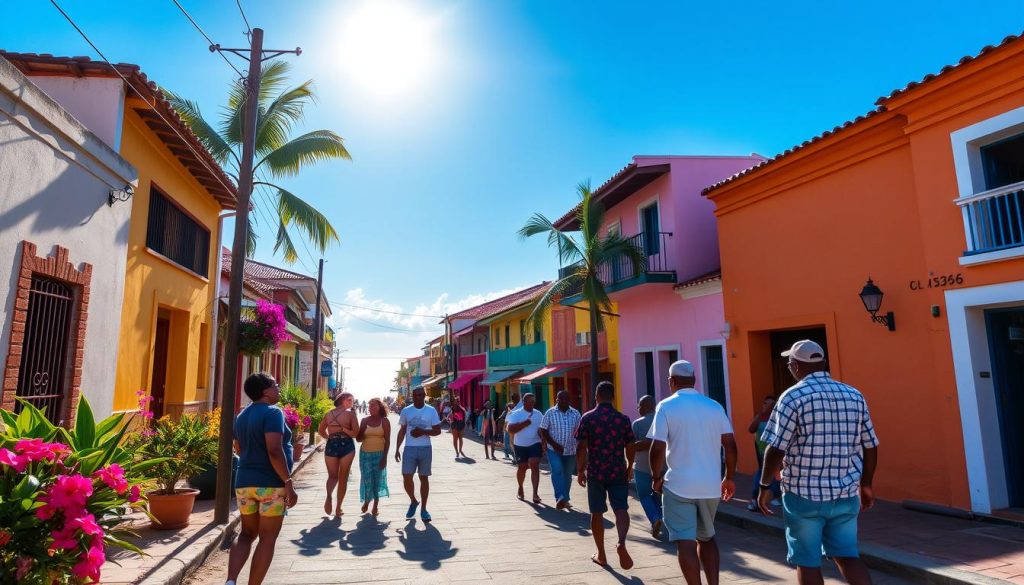
The history of Spanish in Equatorial Guinea is rich. The country was a Spanish colony until 1968. This led to the development of Equatoguinean Spanish, a unique dialect. It shows the blend of Spanish and local languages.
Characteristics of Equatoguinean Spanish
Equatoguinean Spanish has its own special traits:
- About 85% of people speak Spanish
- It’s the main language in schools and government
- It’s influenced by local languages like Fang and Bube
- It’s the only Spanish variety with national official status in Sub-Saharan Africa
“Spanish is not just a language in Equatorial Guinea, it’s a bridge connecting diverse cultural identities.”
Spanish is widely used in Equatorial Guinea. In Bioko and coastal Río Muni, 90% of people speak Spanish. In the interior of Río Muni, it’s spoken by 60-70% of the population. This shows Spanish’s strong presence.
But, there’s a change coming. French is becoming more important in business. This shift is changing how people communicate and the country’s identity.
French Language Integration and Status
In 1988, Equatorial Guinea made French an official language. This was a big step for the country’s language scene. It helped connect Equatorial Guinea to the world through the Francophonie network.
Adding French to schools changed education a lot. Now, French is a must-learn subject. At first levels, most teaching is in Spanish. This mix shows the country’s aim to improve its global talks.
- French became an official language in 1988
- Compulsory subject in educational institutions
- Supports economic and diplomatic connections
About 3 million people speak French in Equatorial Guinea. This shows how important French is getting. French helps with trade, diplomacy, and cultural sharing with Francophone countries.
“Language is the road map of a culture. It tells you where its people come from and where they are going.” – Rita Mae Brown
Learning about French in Equatorial Guinea shows a lively language scene. French is more than just a way to talk. It connects the country to the world.
| Language Metric | French in Equatorial Guinea |
|---|---|
| Official Status | Since 1988 |
| Estimated Speakers | 3 million |
| Educational Role | Compulsory Subject |
Portuguese: The Third Official Language
In 2010, Equatorial Guinea chose Portuguese as its third official language. This move opened up new chances for diplomacy and business. It especially helped the country connect with the Community of Portuguese Language Countries (CPLP).
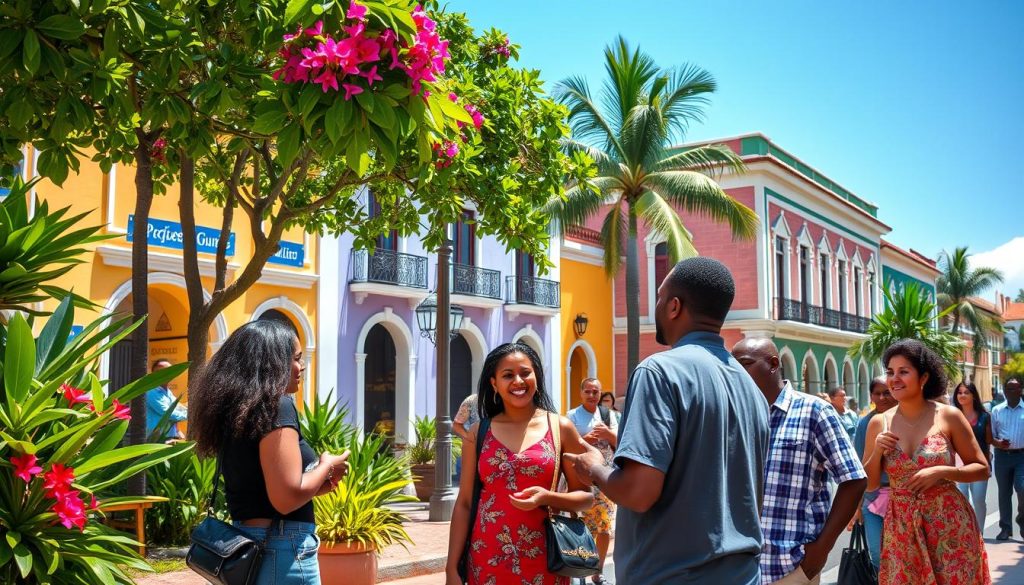
Adding Portuguese as an official language was a smart choice for international relations. With about 20,000 Portuguese speakers, or 1.2% of the population, Equatorial Guinea aimed to make more global friends.
Motivations Behind Language Adoption
Let’s look at why Equatorial Guinea chose Portuguese:
- Membership in the CPLP
- Expanding international diplomatic networks
- Creating new economic opportunities
- Enhancing cultural diversity
“Language is the road map of a culture. It tells you where its people come from and where they are going.” – Rita Mae Brown
Choosing Portuguese shows Equatorial Guinea’s big dreams. By joining the CPLP, the country linked up with Portuguese-speaking nations worldwide.
Implementation Challenges
Adding a new official language is tough. The government is working hard to make Portuguese part of schools, government talks, and public services.
| Language Metric | Equatorial Guinea Portuguese Statistics |
|---|---|
| Total Portuguese Speakers | 20,000 |
| Percentage of Population | 1.2% |
| Official Status | Adopted in 2010 |
Even though not many speak Portuguese, its official status is a big step. It brings more diversity and global connections to Equatorial Guinea.
Indigenous Languages and Regional Recognition
Equatorial Guinea is home to a rich mix of languages. Beyond the official ones, the country’s indigenous languages show its cultural depth. Five of these languages are now officially recognized at the regional level.
The most well-known indigenous languages are:
- Fang: The most widely spoken indigenous language
- Bube: Native to Bioko Island
- Annobonés Creole: Unique to Annobón Island
- Kombe: Spoken in specific regional communities
- Kwasio: Another significant indigenous language
The Fang language is especially important. It’s spoken by many people across the mainland and islands. Its use shows the Fang people’s big role in Equatorial Guinea’s culture.
“Language is the roadmap of a culture. It tells you where its people come from and where they are going.” – Rita Mae Brown
These indigenous languages face challenges in a world where Spanish, French, and Portuguese are more common. But they are key to keeping local cultures alive and traditional ways of talking.
The spread of these languages across Equatorial Guinea is interesting. Bube is mainly found on Bioko Island. But Fang is spoken in many parts of the country.
Language Policy and Implementation
Equatorial Guinea’s language policy is complex. It aims to develop the country and its identity. The policy balances official languages with the needs of indigenous people.
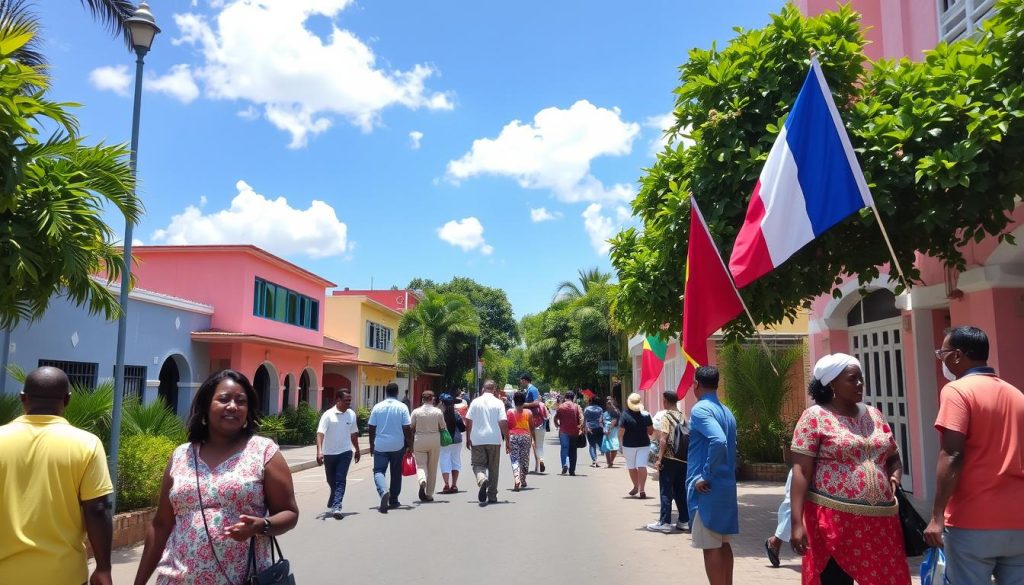
- Promoting Spanish as the main language in schools
- Valuing indigenous languages in local talks
- Supporting many languages in communication
Educational Language Dynamics
Education is central to the language policy. Spanish is used in most classrooms, helping 93% of people learn to read. Schools are important for teaching languages and keeping cultures alive.
“Language is the roadmap of a culture. It tells you where its people come from and where they are going.” – Rita Mae Brown
The government wants to mix official languages with local ones. This helps everyone communicate better and respect different cultures.
Equatorial Guinea focuses on teaching many languages. This way, the next generation can understand both the national and local languages. The policy sees language as a key part of culture.
The Fang Language and Its Cultural Significance
The Fang language is a key part of Equatorial Guinea’s culture. It has about 1 million native speakers. Fang is more than just a way to talk; it’s a treasure of the region’s history and culture.
“Language is the roadmap of a culture. It tells you where its people come from and where they are going.” – Rita Mae Brown
Fang is part of the Niger-Congo language family, within the Bantu groups. It’s spoken not just in Equatorial Guinea but also in Gabon, Cameroon, and the Republic of the Congo.
- Native speakers: Approximately 1 million
- Linguistic classification: Bantu language (Zone A)
- Countries spoken: Equatorial Guinea, Gabon, Cameroon, Congo
The Fang language is more than just a way to talk. It keeps alive traditional knowledge, stories, and social ways. With over 85% of Equatorial Guinea’s people being Fang, the language is key to keeping their culture alive.
| Linguistic Feature | Description |
|---|---|
| Primary Dialects | Southwest Fang, Ntoumou, Okak, Mekê |
| Historical Influence | Impacted by French and Spanish colonial presence |
| Cultural Transmission | Preserves traditional customs and oral traditions |
Even with the push of globalization and official languages, the Fang people hold on to their language. It’s a strong sign of their cultural strength and identity.
Bube and Other Indigenous Languages
In the heart of Equatorial Guinea, the Bube language is a treasure. It’s spoken by about 51,000 people on Bioko Island. The Bube people have a culture that’s over 3,000 years old.
The Bube language is complex. It has 29 consonant sounds and 7 vowel sounds. There are six dialects, showing the area’s cultural variety.
Geographic Distribution and Cultural Significance
Bioko Island is where Bube is mainly spoken. The island is a key place for this language. The Bube people are the second biggest group in Equatorial Guinea, making up about 6.5% of the population.
- Native speakers: 51,000
- Language presence: Over 3,000 years
- Dialects: 6 distinct variants
- Official status: Recognized minority language
“Language is the road map of a culture. It tells you where its people come from and where they are going.” – Rita Mae Brown
Even though Spanish is common in Equatorial Guinea, Bube and other indigenous languages are important. They help keep the culture alive. But, these languages face challenges, mainly because they are passed down through stories and songs.
| Language Characteristic | Details |
|---|---|
| Consonant Phonemes | 29 |
| Vowel Phonemes | 7 |
| Geographical Concentration | Bioko Island |
Keeping Bube and other indigenous languages alive is crucial. We need to document and support them. This is key to keeping the area’s rich language diversity alive.
Language Use in Media and Communication
In Equatorial Guinea, media and communication show a complex mix of languages, with Spanish leading the way. Spanish is key in shaping public talks on various media platforms.
The media scene in Equatorial Guinea is unique:
- Television broadcasts mainly in Spanish
- Radio stations offer programs in many languages
- Print media mostly publish in Spanish
- Digital platforms are starting to include local languages
Even though Spanish is the main language, local tongues are slowly getting more airtime. Local media are working hard to show off the country’s language diversity.
“Language is the road map of a culture. It tells you where its people come from and where they are going.” – Rita Mae Brown
The way people use language in communication is quite interesting:
| Media Platform | Primary Language | Indigenous Language Integration |
|---|---|---|
| Television | Spanish | Low |
| Radio | Spanish/Indigenous Languages | Moderate |
| Digital Media | Multilingual | Growing |
About 87% of Equatorial Guinea’s people speak Spanish. This greatly affects how media talks to the public. The language scene is always changing, affecting how we share and understand information.
Language Politics and Economic Relations
Equatorial Guinea uses language as a key tool in its economic strategy. The country’s language politics have turned communication into a valuable asset.
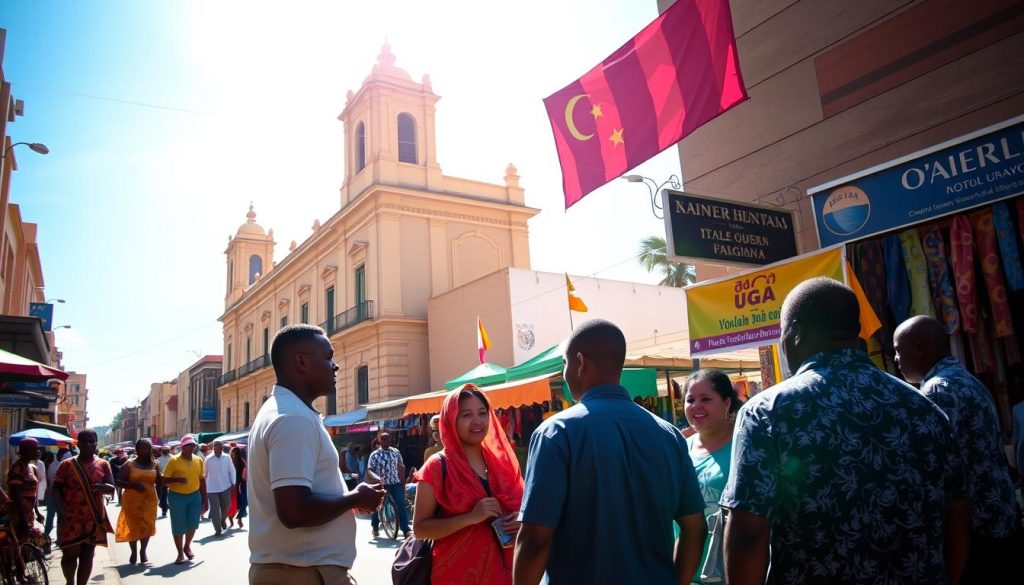
The nation’s economic ties start with its use of multiple languages. By choosing French and Portuguese alongside Spanish, Equatorial Guinea opens doors to more trade.
Strategic Language Investments
The country’s language investments have brought big economic wins. Key benefits include:
- Stronger ties with Francophone and Lusophone countries
- More foreign investment
- Bigger regional economic partnerships
- More job chances
“Language is the roadmap of a culture. It tells you where its people come from and where they are going.” – Rita Mae Brown
Looking at the numbers shows how language politics boost the economy. The country’s smart use of language helps in areas like energy and services.
| Language | Economic Impact | Trade Potential |
|---|---|---|
| Spanish | Primary official language | High regional influence |
| French | Diplomatic expansion | West African markets |
| Portuguese | New economic corridors | Lusophone trade networks |
Knowing about Equatorial Guinea’s language politics helps understand its unique trade and economic growth strategies.
Future of Language Diversity in Equatorial Guinea
The future of languages in Equatorial Guinea is very important. The country has three official languages and fifteen indigenous ones. This mix of languages shows a rich culture that needs careful attention.
There are a few key trends in language diversity:
- More focus on teaching many languages at once
- Use of digital tools to record and share native languages
- Efforts by the government to protect minority languages
- More people around the world interested in language heritage
New technology is helping keep languages alive. Apps, online dictionaries, and digital collections are key. They help young people connect with their culture and keep languages like Fang, Bube, and Gyele alive.
“Language is the roadmap of a culture. It tells you where its people come from and where they are going.” – Rita Mae Brown
But, there are still big challenges. Global trends and economic needs threaten many languages. Yet, Equatorial Guinea’s dedication to language diversity gives hope for its rich communication heritage.
| Language Category | Current Status | Future Potential |
|---|---|---|
| Official Languages | Spanish, French, Portuguese | Strong institutional support |
| Indigenous Languages | 15 active languages | Requires targeted preservation efforts |
| Digital Documentation | Emerging technologies | High potential for language preservation |
Your support is crucial for Equatorial Guinea’s language future. By valuing language preservation, you help keep this nation’s unique culture alive.
Conclusion
Your journey through Equatorial Guinea’s language landscape shows a rich mix of languages. Over 15 languages are spoken in this small country. It’s a place where different cultures meet.
The country’s language diversity comes from its history. This includes colonial times and the traditions of its people. Spanish, French, and Portuguese mix with local languages like Fang and Bubi.
This mix of languages helps keep the country united. At the same time, it keeps cultural identities alive. The fact that 85% of kids go to primary school shows a big effort in teaching languages and keeping cultures alive.
Learning about Equatorial Guinea’s languages teaches us about keeping cultures alive in small countries. With 80% of people being Fang, language connects different groups. It shows how important communication is for unity and growth.
As Equatorial Guinea grows, its language world shows strength and adaptability. The blending of languages is a sign of a vibrant national identity. It celebrates differences and helps everyone understand each other better.
The above is subject to change.
Check back often to TRAVEL.COM for the latest travel tips and deals.
Here are some Tours & Sightseeing suggestions that might pique your interests!
